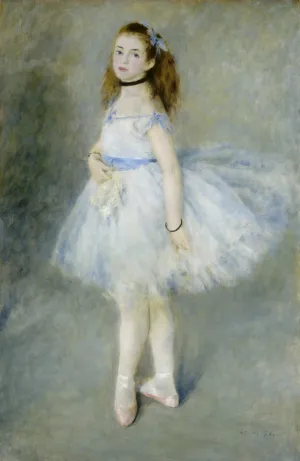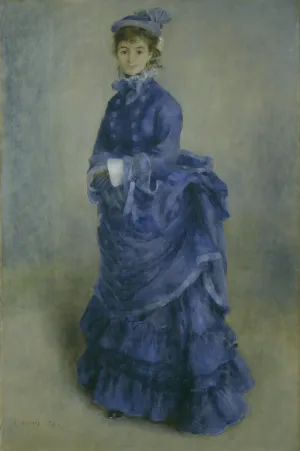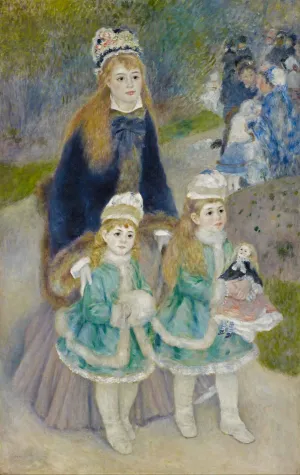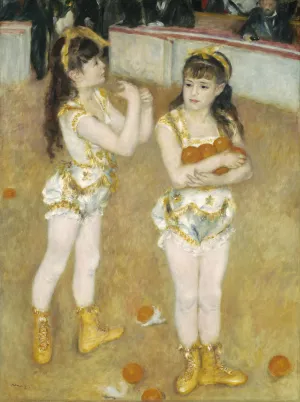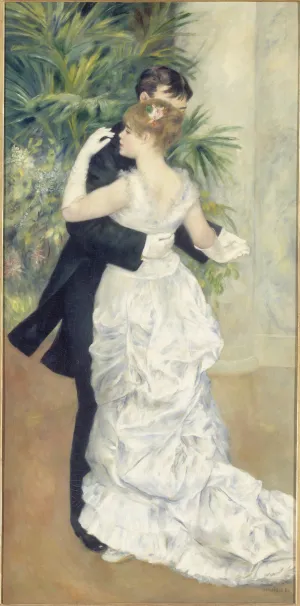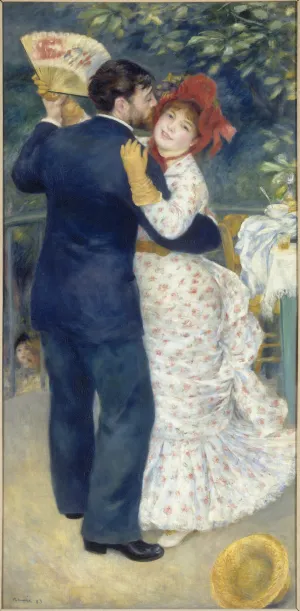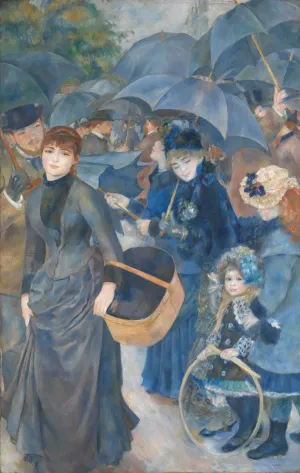Checklist
Pierre-Auguste Renoir (1841–1919)
The Dancer, 1874
Oil on canvas
56 1/8 x 37 3/16 in. (142.5 x 94.5 cm)
National Gallery of Art, Washington, D.C.
Renoir's ballerina is a young dancer in the Paris Opera shown posing on the diagonal floorboards of the practice room, her tutu flaring up behind her. She assumes the ballet's fifth position, in which both feet cross each other, as we see here. Renoir's bright palette and energetic brushwork, so familiar to us today, struck his contemporaries as audacious. The girl's neck, clavicle, and shoulder are modeled in blue; her flesh tones are inflected throughout with touches of blue, green, and yellow.
Pierre-Auguste Renoir (1841–1919)
La Parisienne, 1874
Oil on canvas
64 x 42 in. (163.2 x 108.3 cm)
National Museum Wales, Cardiff
© Amgueddfa Cymru - Museum Wales
Renoir presents his pert subject dressed from head to foot in an outdoor morning toilette of striking blue silk, with matching toque and choker, appropriate for the spring. This Parisienne's walking dress consists of a jacket worn over a double-layer skirt, with the overskirt pulled into a bustle in the back and the underskirt trimmed at the front with two pleated flounces. Initially, Renoir may have intended to present his model in a more defined setting, since he appears to have laid in background elements such as a doorway or column at left.
Pierre-Auguste Renoir (1841–1919)
Madame Henriot "en travesti" (The Page), 1875–76
Oil on canvas
63 1/2 x 41 1/4 in. (161.29 x 104.78 cm)
Columbus Museum of Art, Ohio
Renoir's eighteen-year-old model, Marie-Henriette Grossin—an actress who later adopted the stage name Madame Henriot—appears before a red velvet curtain, with a glimpse of the theater behind her. She is playing a boy's role, as we can see from her costume, and wears a long-sleeved doublet with buttons fastened tightly down the center, reminiscent of a troubadour.
Pierre-Auguste Renoir (1841–1919)
La Promenade, 1875–76
Oil on canvas
67 x 42 5/8 in. (170.2 x 108.3 cm)
The Frick Collection, New York
Photo Michael Bodycomb
A young woman shepherds a pair of identically dressed little sisters along the path of a well-maintained public park. All three figures are outfitted for the cold and in the height of fashion. The eldest wears a blue velvet jacket with wide sleeves trimmed with red fox; the little girls wear miniature blue-green jackets trimmed with either swansdown or white mink. Further up the pathway to the right, Renoir has included no fewer than eleven additional figures and two playful dogs.
Pierre-Auguste Renoir (1841–1919)
Acrobats at the Cirque Fernando (Francisca and Angelina Wartenberg), 1879
Oil on canvas
51 1/2 × 39 1/16 in. (131.2 × 99.2 cm)
The Art Institute of Chicago
Seen from above, but up close—as if observed through opera glasses from one of the cheaper seats— Renoir's young circus girls are shown receiving applause at the end of a performance. The older girl at left takes her bow while her sister holds five of the oranges offered as tribute. It was customary for the best performances in the circus to be recognized by a flood of oranges, often thrown by appreciative children in the audience. Renoir lightly applies his paint in thin, translucent washes. He models the girls' skin tones in Naples yellow and outlines their arms and legs in violet.
Pierre-Auguste Renoir (1841–1919)
Dance in the City, 1883
Oil on canvas
70 3/4 x 35 1/16 in. (179.7 x 89.1 cm)
Musée d'Orsay, Paris
© Musée d’Orsay, Dist. RMN-Grand Palais / Patrice Schmidt
A young couple waltz alone on an immaculate parquet floor in a marble salon, with palms and indoor plants behind them. The woman, her hair in a chignon adorned with a single pink rose, is wearing a "toilette de bal" of white satin or silk taffeta, with organza, lace, or chiffon trimming around the neck and shoulders of the bodice. Her neck and back are most likely powdered, and she wears elbow-length white gloves of satin or leather, an essential accouterment for her sleeveless ball gown. Here Renoir used two of his friends as models.
Pierre-Auguste Renoir (1841–1919)
Dance in the Country, 1883
Oil on canvas
71 x 35 7/16 in. (180.3 x 90 cm)
Musée d'Orsay, Paris
© Musée d’Orsay, Dist. RMN-Grand Palais / Patrice Schmidt
Dance in the Country was painted as a companion to Dance in the City. It shows a couple dancing on the terrace of an outdoor restaurant. They appear to have just left their table, which is covered by a small tablecloth, napkins, a cup and spoon, and a half-filled decanter and glass. Renoir's friend Paul Lhote posed for the dancer in a dark woolen lounge suit; we see him again in an elegant dresscoat with tails in Dance in the City.
Pierre-Auguste Renoir (1841–1919)
Dance at Bougival, 1883
Oil on canvas
71 5/8 x 38 5/8 in. (181.9 x 98.1 cm)
Museum of Fine Arts, Boston
Probably the last of these three Dance pictures to be completed, Dance at Bougival is the most romantic of the trilogy. Eyes masked by his boatman's straw hat, the male partner expresses his intentions through body language that is as legible today as it would have been a century and a quarter ago. His female companion's willing compliance completes the harmony, both visual and sensual, that is at the heart of this painting. The touching of ungloved hands and the proximity of the dancers' faces would have appeared audacious to a late nineteenth-century audience.
Pierre-Auguste Renoir (1841–1919)
The Umbrellas (Les Parapluies), c. 1881–85
Oil on canvas
71 x 45 1/14 in. (180.3 × 114.9 cm)
The National Gallery, London
The Umbrellas was begun in 1881, abandoned that year, and only returned to and completed in 1885. The figures in the foreground on the right, executed in 1881, are painted in the colorful palette and with the feathery handling of Impressionism. We see an elegantly attired mother, leaning forward slightly and accompanied by her two daughters, and a well-dressed young woman behind her, about to open her umbrella.

